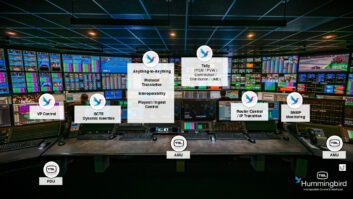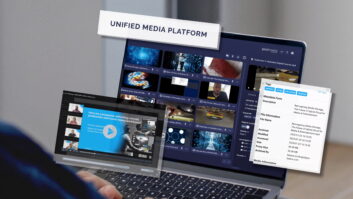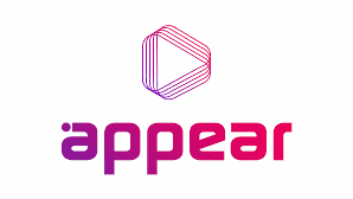The Broadcasting industry is experiencing a tidal wave, with the desire for content and the rapid development of new screens, new devices and new platforms. This means that companies are generating more and more content that must be available at the drop of a hat with VoD and OTT services making the time from processing to screen that bit quicker.
Having an efficient workflow is more crucial than ever before; luckily for the industry, there are companies that are working tirelessly to meet the ever evolving demands of broadcasters. A new term emerging in the broadcasting industry: the new kid on the block if you will, is the hybrid workflow.
Entering a Hybrid World
But what is a truly hybrid workflow? Martin Bailey, partner account director, UK & Ireland, Dynatrace commented that hybrid workflows are: “when a transaction/user action results in a flow which traverses multiple environments.”
In recent years, we have witnessed the sharp increase in the trust and popularity of the cloud, with many companies rapidly utilising the cloud network to store content. However, many companies are now experiencing the drawbacks of only storing on cloud, and so the emergence of hybrid workflows appear to be becoming more and more appropriate and desirable. Jon Morgan, CEO, Object Matrix added that: “on premise and cloud elements that work in harmony produce the best possible efficiencies in storing, handling, sharing and distributing media assets.”
The demand for the cloud has grown throughout previous years, with opinions ranging from “‘this will never work for us’ to ‘we are migrating to the cloud forever’” commented Tim Burton, managing director, Magenta.
As experience is maturing, so are the opinions, with companies appreciating the benefits of the flexibility of the cloud, but still acknowledging the abilities, and the necessity of on-premise. Scott Dryburgh, account director, Century Link commented that: “Companies are finding a balance between resources, time, people and processes. They are realising the initial ambition of moving to a hybrid workflow.”
Best of Both Worlds
Jon Morgan commented that: “Media companies very much have the need for around the clock and around the world editing, for back up on premise, and for taking advantage of on-demand services.” The dual abilities of the two storage management platforms makes for the best of both worlds of broadcasting companies. On-premise has the advantage of speed and connectivity to existing software.
Meanwhile, the cloud is useful for sharing content with other off-premise users, with a geographically distributed backup. Tim Burton added that: “the hybrid position we are in isn’t wholly one way or another, with a much more pragmatic position and less miss-information. The industry seems more able to recognise the pros and apply them to business abilities.”
The cloud experienced a rapid growth in previous years, with the belief that it was the future, and the only route to the future. When considering the benefits of a hybrid workflow, Tim Burton has argued that it is important to: “analyse the strength of both on premise and cloud and work to the two.” As opinions on the cloud environment and more companies have developed a mature understanding of the concept, opinions have become more established and settled, while the potential for hybrid workflows to offer a manageable entrance into the cloud environment has grown. “Businesses want to take advantage of new technologies and efficiencies so look to see what can be migrated to the cloud and what needs to be kept in-house,” added Martin Bailey.
Erik Åhlin, CEO and Co-Founder, Vidispine commented that: “We see hybrid cloud implementations as a natural migration path for media companies that can’t move all content to the cloud, giving them access to the scalability and innovation provided by a public cloud, while still retaining what is necessary on-premise.”
The Transition
As the explosion of content and the technological revolution has taken place, it has heavily impacted the broadcasting industry, and the way providers are storing their content. Erik Åhlin commented that: “Now the industry is going through changes on all fronts and will need to have systems that can adapt to the changes today and tomorrow.”
With the reliability of the cloud being proven over the last few years, and the emergence of solutions that specifically target media company’s needs, as discussed by Jon Morgan: “Hybrid models are suited to organisations in the media industry who need to manage unpredictably large amounts of high resolution video content on a daily basis,” coupled with the applicability of the cloud when combined with on premise structures, the hybrid workflow is more suitable for broadcasters than ever before. Scott Dryburgh pointed out that: “Broadcasters are very resourceful people. They are driven by a necessity to fulfil the needs for producing and generating content, and they are finding that a fully on-premise, or fully cloud approach is not suitable for some of the challenges they face.”
Companies, however should not blindly enter the world of the cloud, whether it be in a hybrid workflow or not. Despite its multiple benefits, the cloud is not suitable for everyone. Justin Carroll, account director, Dynatrace commented that: “Hybrid multi-cloud environments have the potential to solve a great deal of the media industry’s biggest challenges in reliably bringing more engaging content to its audiences. However, these more dynamic, distributed environments introduce a new type of complexity that must be overcome to minimise the risk that performance problems will impact audience experiences. Highly scalable monitoring capabilities that can provide insight into every viewer’s experience in real time will be crucial.”
Furthermore, media companies must assess the applicability of hybrid workflows, and what aspects of each platform they require before delving into spending budgets. Martin Bailey added that: “It is important for broadcasting companies to consider what their companies are accessing and how especially for volume-intensive applications that media companies require.” As well as this, the time and effort required to migrate to the cloud is crucial, with the skills, people, processes and effort required often underestimated. “It is much more complex than some people think,” commented Scott Dryburgh.
Erik Åhlin reminded us that: “the choice of migrating to the cloud is very much a strategic business decision, not only a technical decision, and same of course goes for hybrid workflows.”
The Solutions
The coming years are likely to see a large migration to hybrid workflows that Scott Dryburgh has said will be: “Collaboratively led and future rich.” Companies will become more aware of the benefits of hybrid workflows, such as the combining of two platforms to enhance each offering’s benefits and overcome numerous broadcasting challenges.







